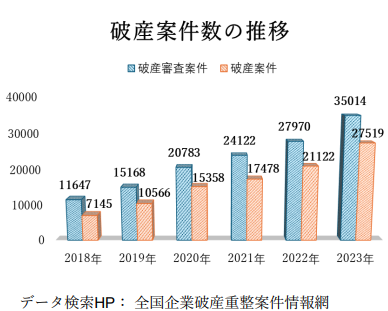1 増加する破産案件
中国の最高人民法院は、2016年8月より「全国企業破産 重整案件情報網」というHPにおいて、全国の破産案件に 関する情報を公開しているが、当該HPにて1年ごとに破 産審査案件数及び破産案件数を検索した結果は以下の表 のとおりである。これを見ると、中国の破産案件数は近 時増加の一途をたどっていることがはっきりと見て取れ る。

http://pccz.court.gov.cn/pcajxxw/index/xxwsy
2 中国の倒産制度
Il 27 settembre 2024 è stato pubblicato in Gazzetta Ufficiale il D.Lgs. 13 settembre 2024, n. 136 (“Correttivo-ter”), è il terzo – e attualmente ultimo – Decreto Correttivo al Codice della Crisi d’Impresa e dell’Insolvenza. Il novello decreto correttivo ha apportato modificazioni sostanziali a numerosi istituti del Codice della Crisi.
On September 27, 2024, Legislative Decree No. 136 of September 13, 2024 (“Correttivo-ter”) was published in the Official Gazette. This represents the third—and currently final—Corrective Decree to the Business Crisis and Insolvency Code. The new corrective decree has introduced substantial amendments to several provisions of the Crisis Code. Beyond minor stylistic and detailed adjustments, the Correttivo-ter both incorporates certain practices or clarifies interpretive uncertainties and introduces some highly anticipated innovations for practitioners.
Deeds of Company Arrangement – Insured Claims
Destination Brisbane Consortium Integrated Resort Operations Pty Ltd as Trustee v PCA (Qld) Pty Ltd (subject to a Deed of Company Arrangement) [2024] QSC 178 ("Destination Brisbane")
In Destination Brisbane two questions, which concerned the entitlements of insured creditors under a DoCA, arose for consideration in the context of an application for judicial advice:
Introduction
The insolvency process is a structured approach to resolving financial distress for individuals and businesses. Understanding this process is critical for making informed decisions and recovering from insolvency. This guide offers a detailed roadmap to navigate the complexities of insolvency and regain financial stability.
Recognizing Financial Warning Signs
Insolvency doesn’t happen overnight—it develops over time. Early detection of financial trouble can help avoid severe consequences.
المقدمة
الإفلاس هو حالة مالية قد تواجه الأفراد أو الشركات عندما تصبح الديون أكثر من القدرة على السداد. يمكن أن تكون هذه الحالة مرهقة، ولكن فهم الإفلاس والتصرف مبكرًا يمكن أن يساعد في تجنب المزيد من التعقيدات المالية. في هذا المقال، نقدم لك دليلًا شاملًا للتعامل مع الإفلاس بفعالية.
الأسباب الرئيسية للإفلاس
للأفراد
The UK construction sector is experiencing an increasing rate of insolvency, with recent data revealing that construction firms accounted for 17.4% of all insolvencies in England and Wales in August 2024. Over the past year, the total number of construction firms becoming insolvent has increased by 2.1%.
Introduction
Insolvency is a financial condition that occurs when an individual or business cannot meet its debt obligations as they fall due or when liabilities exceed assets. This state of financial distress can have profound implications, making it essential to understand the warning signs, consequences, and pathways to recovery.
Key Indicators of Insolvency
Inability to Pay Bills on Time
Falling behind on payments is a major red flag, signaling cash flow issues.
On November 7, 2024, a 3 (three) judge bench of Hon’ble Supreme Court of India (“Supreme Court”) delivered their judgment in the matter of State Bank of India and Ors. vs. The Consortium of Mr. Murari Lal Jalan and Mr. Florian Fritsch and Anr.1,inter alia, ordering liquidation of Jet Airways (India) Limited (“Jet Airways”).
It is not uncommon for contractors, in several industry sectors, to contract with a special purpose vehicle (SPV), whose day-to-day management is effectively controlled by a parent company, and the SPV has with little to no assets beyond cash flow provided by its parent. In this article we look at what a claimant could do outside of the traditional insolvency process in circumstances where the SPV goes into a form of external administration such as administration or liquidation and there are no assets available to the external administrators.
